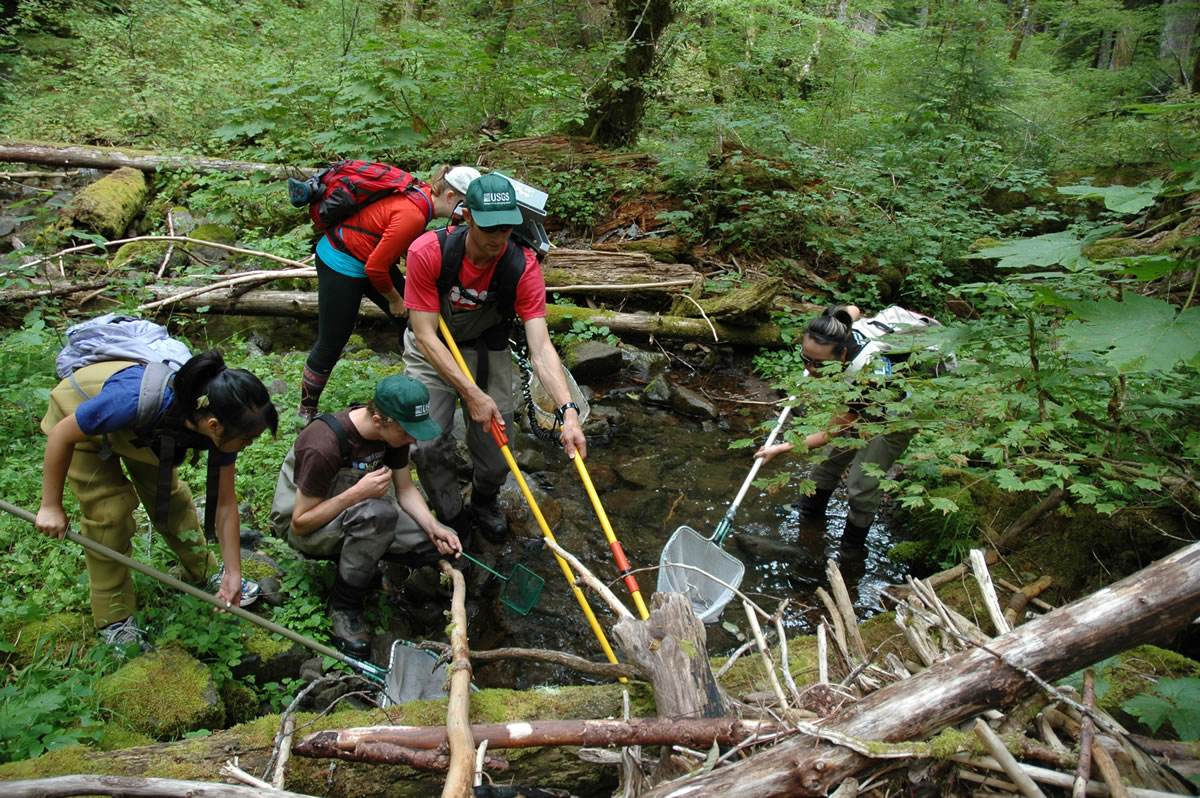CARSON — Layout Creek, deep in the Wind River valley, is little more than a dribble in mid-summer. Many spots are just shallow pools isolated from each other by yards of damp — or dry — rock.
Amazingly, living in these disconnected pockets of inches-deep water are wild steelhead, so young and small they are measured in millimeters.
“This is a good time to sample for these fish,” said biologist Ian Jezorek of the U.S. Geological Survey as he carried a 30-pound electroshocker over and under log jams and through prickly devil’s club up Layout Creek. “At higher flows it gets much harder to capture them.”
Jezorek led a crew from the Geological Survey and the Forest Service last week capturing the young steelhead and inserting tiny tag, called a Passive Integrated Transponder, into their body cavity.
The tag has no battery, but emits a signal when energized by an antenna or detection system. Each tag has a unique number and is entered into a central database used by fishery agencies and others throughout the Columbia River basin.
There are five instream detection systems to record the tags in the Wind River watershed alone, plus there is the chance of recapture at smolt traps operated by the state Department of Fish and Wildlife in the spring.
Detection systems are at many other locations along the Columbia — primarily at dams.
“We can learn so much about the life history of these (tagged) fish,” Jezorek said. “We can (track) down what they are doing and what portion of the watershed is important to their survival.”
David Hu, fisheries program manager for the Gifford Pinchot National Forest, said the Wind River is a key watershed for recovery of lower Columbia wild steelhead, which are listed as threatened under the federal Endangered Species Act.
“It’s a unique wild steelhead stronghold with only natural production, no hatchery,” Hu said.
Trout Creek, a major tributary of the Wind, has been designated a priority watershed for restoration efforts by the Forest Service.
To that extent, the agency removed small dams in 2009 on Trout Creek at Hemlock and in 2012 on Martha Creek to improve habitat and fish passage.
Stephanie Caballero, a fish biologist for the Mount Adams District, said the Gifford Pinchot National Forest hopes to replace a culvert on Layout Creek that’s a partial barrier to steelhead passage with a bridge.
This is the second year of surveying Layout Creek and placing the PIT tags in the fish. Bonneville Power Administration is paying for the research.
“We want to be able to evaluate restoration projects,” Caballero said.
Jezorek said evaluating projects gives natural resource agencies guidance on how to spend restoration dollars.
“It’s tough to evaluate restoration,” he said. “There are a lot of variables influencing fish populations.”
The stocking of hatchery-origin steelhead in the Wind River ended in 1998 to give wild fish a better chance to recover.
As many as 1,500 wild fish have returned in recent years. State officials tout the Wind River as a showcase for wild steelhead recovery.
In fact, catch-and-release sport fishing is allowed in the Wind upstream of Shipherd Falls from Sept. 16 through Nov. 30 as long as the state estimates the run is at least 500 fish.
Jezorek and his crew captured and tagged 36 fish in a stretch of about 0.3-mile of Layout Creek for the day. The length and weight of each fish is recorded.
The crew recaptured nine fish that were tagged in 2012.
“We’ll get a year’s worth of growth data on those fish,” he said.
Among the information to be learned is whether the fish are migratory and eventually will move down Layout and Trout creeks, then the Wind and Columbia rivers, to the ocean or not.
It is possible some are resident rainbow trout who lives their entire lives in the watershed, Jezorek said.
The tags are just 12 millimeters in length.
Hu said laboratory studies with chinook and steelhead show no adverse effect of the tag on growth or survival.
“Collaboratively restoring these fish, that’s our No. 1 forest fish program goal,” Hu said.




